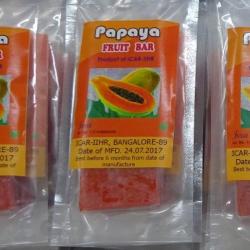OSMOTIC DEHYDRATION OF FRUITS (PAPAYA, GUAVA, AONLA)
Technology for Making Papaya Fruit Bar:
Papaya is an important fruit crop of India. It is known for its excellent flavour, delicious taste and it is rich in vitamin A and C. The perishable nature of papaya is a major drawback for transport of the fruits to distant places and storage during glut in the market. There are very high post-harvest losses of papaya fruits in India. Sometimes the farmers are not able to sale very small or very big fruits in the fresh market resulting huge losses. This technology helps in utilization of papaya fruit in to bar which is not available commercially. Fruit bars are highly preferred processed products as they are nutritious, good eye appeal, delicious, easy to transport, convenient with good shelf life. One of the problem in making papaya bar is that it does not dry as full leather such as mango bar and develops crack in the sheet. A process has been developed to reduce water content in papaya pulp and use the same for bar making. The final product is of natural papaya flavor, with very good appearance and taste. The product can be consumed as confectionery item (snack). This is highly suitable for children, mountaineers, defense forces in difficult areas where carrying and delivering bulky and perishable fresh fruits is difficult. It is a dehydrated product suitable for manufacture under micro/ small and medium size industries. This technology may encourage small scale processing units in rural areas.
About 7-8 kg ripe fruits are required to make one kg of fruit bar and shelf life of product is six months under ambient conditions.
Technology for Osmotic Dehydration of Guava slices
Guava fruits are fleshy, juicy with agreeable sweet taste and therefore relished more as fresh fruits. It emits a sweet aroma and is pleasantly sweet and refreshingly acidic in flavour. It is a good source of vitamin C. Guava fruit is highly perishable in nature and need value addition. Traditionally guava is processed into various products such as jelly, juice, fruit bar. etc., A pre-treatment, such as osmotic dehydration, can be used in order to reduce the initial water content, reducing total processing and air-drying time. This is the technology for making dehydrated slices using ripe guava fruit from white as well as pink fleshed varieties. Osmo-air dried fruits are the dehydrated fruit products based on the novel approach towards dehydration. First stage in osmotic dehydration is removal of water using concentrated osmotic medium (sugar syrup) followed by dehydration of osmosed slices using hot air drier to a moisture content about 15%. The product can be used alone as dried fruit (snack) or as adjuvant with other dried fruits like dates, cashew, almond etc., It can also be used in ice-cream industry, confectionary, fruit salads, kheer, cakes and bakery products. This is highly suitable for children, mountaineers, defense forces in difficult areas where carrying and delivering bulky and perishable fresh fruits is difficult. The process is very simple and does not require sophisticated equipment’s. This can be adopted by small scale processor, SHGs and other entrepreneurs.
About 7-8 kg ripe guava fruits are required to make one kg of osmo-air dried slices and shelf life of product is six months to one year under ambient conditions.

Osmotic Dehydration of Guava slices
Technology for making dehydrated Aonla segments infused with Kokum juice
Aonla or Indian gooseberry (Emblica officinalis Garten) has wide popularity all over the world because of the medicinal properties. The high level of ascorbic acid makes it good as an antiscorbutic, diuretic, laxative and antibiotic. Kokum ( Garciniaindica) fruit is rich in antioxidant and its juice improves the digestion and appetite. Both aonla and kokum have health benefits but they also are highly perishable in nature. These fruits are not consumed freely in fresh form due to its astringent taste. Osmotically infused aonla segments in kokum juice will have combined goodness of both the fruits, with easy to eat product having good natural red colour, flavour and texture. Osmotically dehydrated aonla segments are less acidic and astringent and of good taste. The product can be used alone as dried fruit (snack) or as a adjuvant with other dried fruits like dates, cashew, almond etc. This is highly suitable for children, mountaineers, defense forces in difficult areas where carrying and delivering bulky and perishable fresh fruits is difficult. Kokum infused products are not available in the market. This can be adopted by small scale processor, SHGs and other entrepreneurs. The quality of osmotically dehydrated product is near to the fresh fruit.
About 4-5 kg aonla fruits along with 2 kg of Kokum fruits are required to make one kg of osmo-air dried slices and shelf life of product is 1 year under ambient conditions.

Dehydrated Aonla segments infused with Kokum juice

